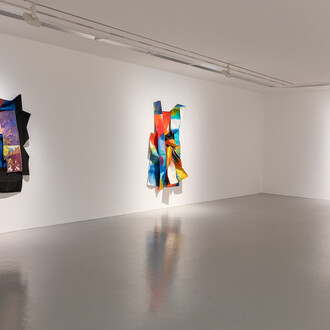The French Diplomat’s Office is a site-specific installation of a key work by this significant American artist, and the first time Barbara Bloom has shown in Ireland. The French Diplomat’s Office is an exploration of painting, set-design, décor, narrative and, in this installation designed specifically for Project Arts Centre, theatre. Barbara Bloom is an artist known for her literary allusions, the resurrection or reinterpretation of found and treasured objects, and what the artist calls ‘visual innuendo’, infusing the stories and scenarios we can know and imagine to inhabit objects, artefacts and artworks.
The Watercolour
A watercolour found on a flea market in Paris in the 1980s is apparently a rendering of an interior decorator’s idea of an office. We shall refer to it as the ‘French Diplomat’s Office’. It conveys that combination of modernist austerity and gilt-edged historicism that is such a forceful marker of the post-war ‘haute monde’. The anonymous artist attended carefully to the fluting of the furniture legs, to all the details of furnishing and decoration. But the carpet is peculiarly depicted far more abstractly: does it have a quasi-geometric pattern, or is it rather a depiction of fallen shadows? At a second glance, it becomes obvious that shadows are not an impossibility. If those long dark stripes were cast by the framing of the windows, surely they should not end halfway up the room? What optical explanation could there be for the strange intensification of colour beneath the desk? Instead of evocations of light, concrete slabs of umber are laid down with no regard for physics.
The Carpet
A facsimile has been fabricated of the carpet depicted in the watercolour. Its pattern is an aerial view of what we see in the image with the following additions: The places where a piece of furniture would have touched the carpet are indicated by grey woven marks carved slightly into the pile. Footprints of a man and a woman have been woven and carved into the carpet, appearing near the couch (where the pair may have been involved in conversation) and walking over to a window – one follows the other, perhaps dancing a few steps, before stopping to look out together, or pausing somewhere close together. The footprints indicate some invisible narrative, some interaction that took place in this room between a fictional ‘French Diplomat’ and an unidentified woman.
The watercolour’s peculiar take on the experience of objects in space seemed to demand that the abstracted room become an actual one, the abstractions made concrete. With the addition of a stage, the gallery space becomes a theatrical setting. The few rows of chairs are ready to seat gallery viewers – empty, anthropomorphic stand-ins for an audience attending a theatre event. On stage the carpet has a solo role in a setting that might trigger an inkling of a narrative. The wall colour and stage set match those of the watercolour, though the paintings have been replaced by simple rectangles of darker colour. The only trace of the furnishings is now incorporated into the carpet design. The theatricality and suggestiveness of the watercolour remain, forming an odd sense of a world not quite properly understood. The effect might be similar to the French Nouveau Roman, a literary form from the mid-20th century by authors including Marguerite Duras and Alain Robbe-Grillet. Rejecting the novel’s traditional focus on plot, action, narrative, ideas or character, these writers suggested a form focused on objects, subordinating plot and character to the details of the world. This sparse depiction of absence might be referred to as visual innuendo.
Barbara Bloom
Born in Los Angeles in 1951, Barbara Bloom is an artist who can turn collections into riveting stories, objects into talismans, and an exhibition into a vortex. Her practice shows a deep care for the objects and histories that make up our collective cultural holdings – suggesting and coaxing us to will further dimensions into an experience of life – ones that are subjective, reflective and fuelled by the imagination.
"A drink before, and a cigarette after, are the three best things in life," (as quoted by Barbara Bloom).



















